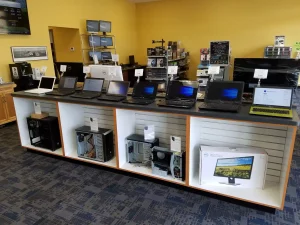Selling pre-owned hardware can be challenging for creatives looking to recoup their investment. However, with a well-thought-out approach, sellers can unlock the full potential of their used equipment. Understanding market intricacies and maximizing value when selling pre-owned hardware is crucial in positioning hardware for optimal returns. By delving into the complexities of selling pre-owned hardware, it becomes clear that a strategic mindset can transform used equipment into a lucrative opportunity.
Key Takeaways
- Identify the hardware’s condition, functionality, and rarity to determine its value and appeal to potential buyers.
- Research market demand and trends to set a competitive and realistic sale price for the pre-owned hardware.
- Create a persuasive product listing with high-quality images and detailed descriptions to showcase the hardware’s features and benefits.
- Employ negotiation tactics and be adaptable to buyer concerns to secure a profitable sale while maintaining a clear understanding of the hardware’s worth.
- Consider the original purchase price and evaluate the hardware’s condition to determine a fair and competitive sale price that maximizes returns.
Understanding Pre-Owned Hardware’s Worth
What determines the value of secondhand hardware, and how can creatives accurately assess their used equipment to maximize value when selling previously owned hardware? The answer lies in understanding the factors that impact resale value. By considering state, functionality, demand, and market trends, creatives can accurately evaluate their pre-owned hardware and maximize value when selling, ultimately achieving the best returns in their creative endeavors.
Identifying Key Factors for Maximization
When evaluating pre-owned hardware, creatives must pinpoint the key elements that influence resale value, as identifying these important factors is vital in maximizing value when selling pre-owned hardware. Factors such as condition, functionality, and rarity significantly impact resale value. Moreover, demand, market trends, and original purchase price also play a significant role in determining the best sale price.
Pricing Strategies for Optimal Returns
To guarantee maximum returns when selling pre-owned hardware, creatives must adopt a strategic pricing approach that takes into consideration the key factors influencing resale value, as identified earlier. This involves setting realistic prices based on market demand, competitor analysis, and the hardware’s condition. By doing so, sellers can maximize value when selling pre-owned hardware, achieving the best returns in their creative endeavors.
Effective Listing and Marketing Techniques
Crafting a persuasive product listing is vital to attracting potential buyers and maximizing value when selling pre-owned hardware, as it serves as the primary touchpoint between the seller and the buyer. Utilize high-quality images, detailed descriptions, and accurate specifications to showcase the hardware’s condition and features. Harness social media and specialized marketplaces to reach a targeted audience, increasing the likelihood of a successful sale.
Negotiation Tactics for Best Results
When engaging with potential buyers, it is crucial to employ negotiation tactics that balance firmness with flexibility to achieve the best possible sale price for your pre-owned hardware. Maximizing value when selling pre-owned hardware requires adapting to buyer concerns while maintaining a clear understanding of your hardware’s worth. By doing so, you can confidently negotiate and secure a profitable sale.
Frequently Asked Questions
Can I Sell Pre-Owned Hardware if It’s Still Under Warranty?
Yes, you can sell pre-owned hardware still under warranty, but make sure you disclose the warranty status and any transfer requirements to potential buyers to maintain transparency and avoid disputes.’
Do I Need to Provide Original Packaging and Accessories?
When selling pre-owned hardware, providing original packaging and accessories is not always necessary, but including them can greatly improve the resale value and appeal to potential buyers seeking a complete, like-new experience.
How Do I Handle Returns or Refunds for Pre-Owned Hardware?
When handling returns or refunds for secondhand hardware, establish a clear return policy, communicate it to buyers, and be prepared to provide refunds or replacements in a timely and professional manner to maintain customer satisfaction.
Can I Sell Pre-Owned Hardware on Multiple Marketplaces Simultaneously?
Selling secondhand hardware on multiple marketplaces simultaneously is possible, but it’s essential to manage inventory, pricing, and shipping efficiently to avoid overselling and maintain a positive seller reputation across platforms.
What if I’m Not Sure About the Hardware’s Original Purchase Date?
When unsure about the initial purchase date, research the product’s serial number or manufacturer’s records to estimate the age, or consider consulting with the original seller or manufacturer for documentation assistance.
Conclusion
Optimizing the sale of pre-owned hardware requires a thorough understanding of its worth. By evaluating key factors such as condition, functionality, rarity, demand, and market trends, sellers can determine an ideal sale price. Strategic pricing approaches and effective listing and marketing techniques can further boost the hardware’s value. Negotiation tactics can be employed as well to achieve the best results. By adopting these strategies, sellers can maximize returns on investment and achieve successful sales.
Also read: How Homemade Gifts Elevate the Home Buying Journey


